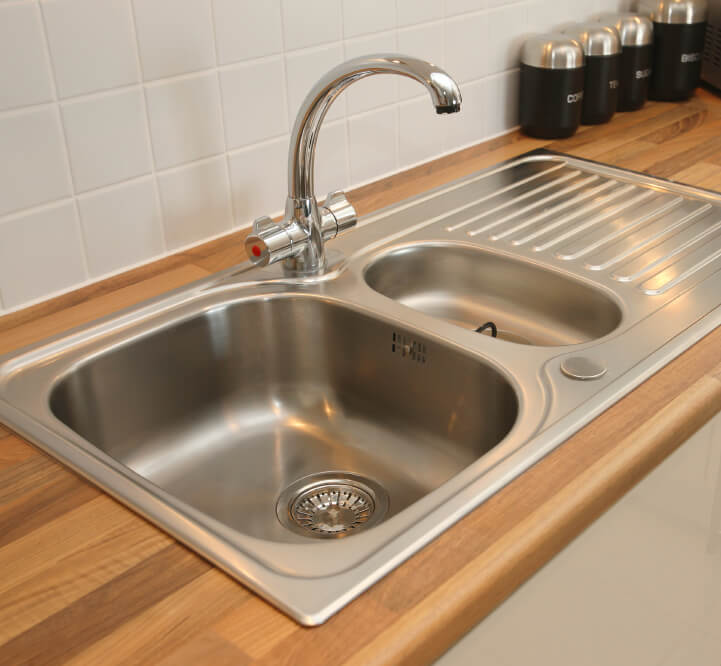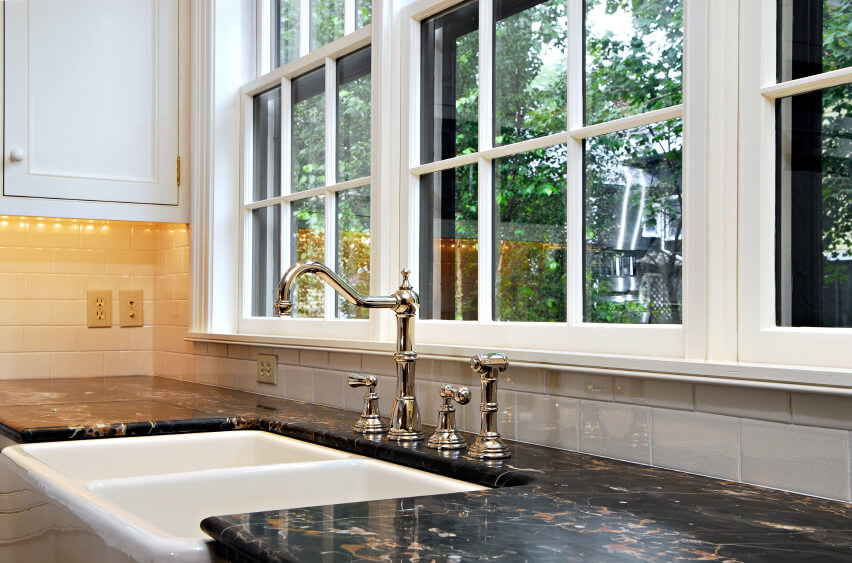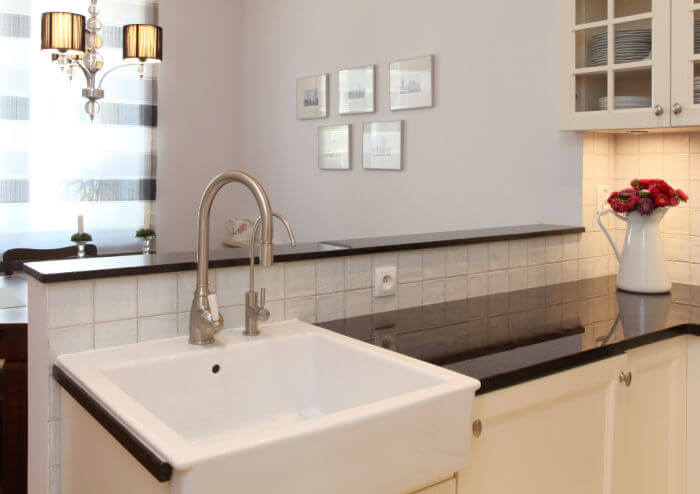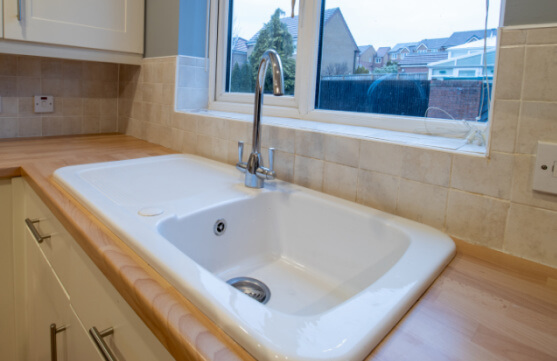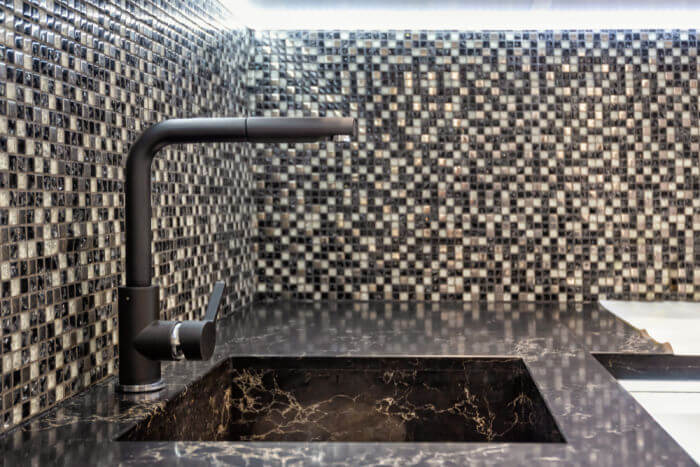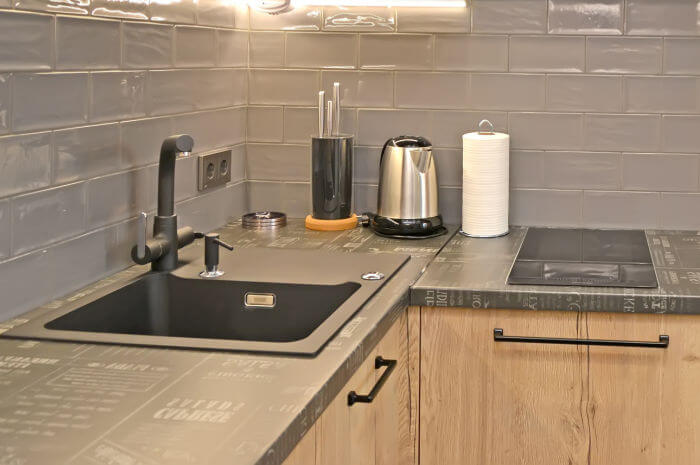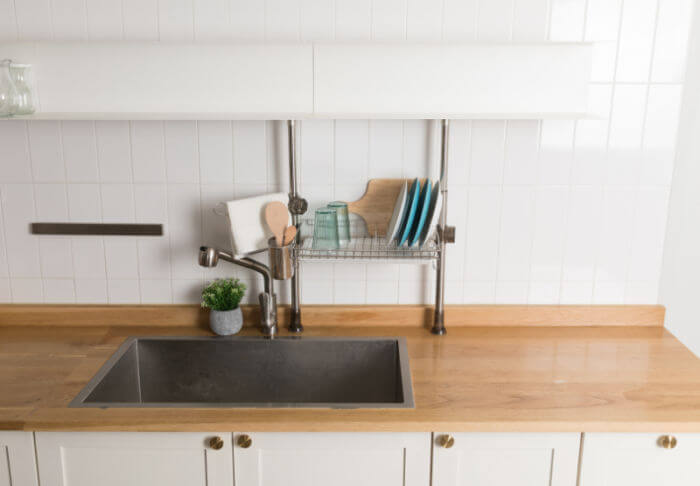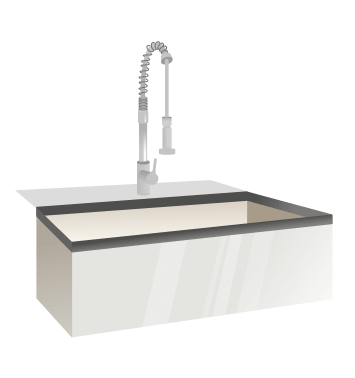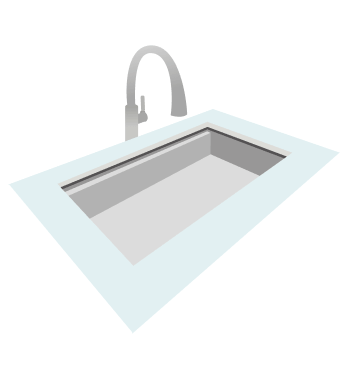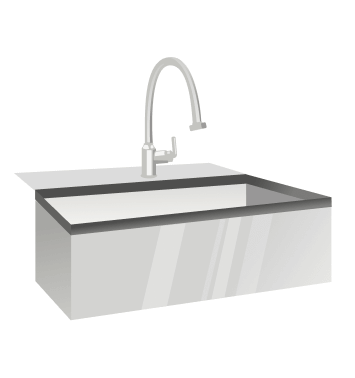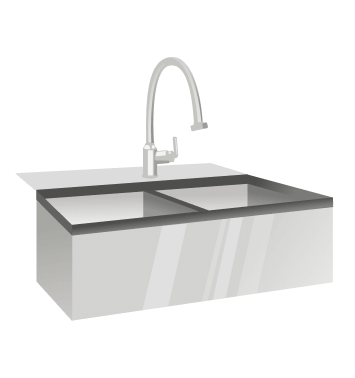Choosing a Type of Kitchen Sink
Few things in your home are used as often as the kitchen sink. From cooking and food prep to cleaning and hand-washing, the kitchen sink is often used several dozen times each day. The type of kitchen sink you have also plays a huge role in the overall look and feel of your kitchen. According to the 2021 Cost vs. Value Report, a minor kitchen remodel project, such as updating a kitchen sink, can yield a 72.2% return on investment in home value.
Choosing a new kitchen sink to complete a kitchen remodel brings up many questions. For example, are appearance and style are more important, or is functionality the most important factor? The good news is that there are so many types of kitchen sinks available today that you will be sure to find a new kitchen sink that ticks off all the boxes.
On this page, we cover popular types of kitchen sinks – both for materials and styles. You will be sure to find one that fits your style and budget.
Best Kitchen Sink Materials
Choosing the best type of kitchen sink is mostly a matter of personal preference. However, some kitchen sink materials are a bit more durable and scratch/stain resistant than others, and some styles work better in remodel situations.
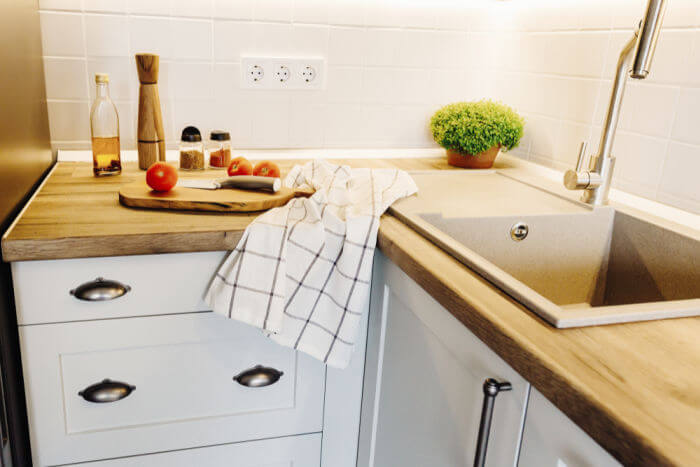
Below are 8 types of kitchen sink materials, along with their pros and cons, to give you a better idea of which type of sink works best for your particular project. We go over which materials hold up well under heavy use, which work better in light- to medium-use scenarios, and basic cost estimates.
Stainless Steel Kitchen Sinks
Stainless steel is one the most prevalent types of kitchen sink materials used in modern home design.
When researching stainless steel kitchen sinks, look for basins made from heavier gauge (thickness) steel. These will be more dent-resistant than thinner-gauge stainless steel. We recommend choosing a stainless steel sink that is between 16 to 18 gauge.
Stainless steel lends itself to modern design and works well with natural stone countertops. It is easy to clean and maintain and should last up to 30 years, and is bacteria-resistant. However, stainless steel can be prone to scratching and denting. It also can be a bit loud when dropping in dishes or silverware. Base models can start around $240, with higher-end designs costing upwards of $800 or more.
Copper Kitchen Sinks
A copper sink adds distinctive flair and style to your kitchen’s décor. Copper sinks are typically hand-made, and some have a bit of zinc (around 1 percent) added to give the basin additional strength.
There are pros and cons to copper kitchen sinks to be aware of. Benefits include unmatched aesthetics, an extremely long lifespan, and natural resistance to rust and corrosion. Copper also takes on a unique patina, which forms naturally on copper, brass and similar materials. This can be both good and bad. You will have to scrub the surface regularly to remove the patina, though its appearance may actually prove visually pleasing.
Like stainless steel, copper sinks are rated by the thickness of the metal. Choose a 14 to 16 gauge for a more durable sink. Also, look for a kitchen sink with welded seams, as it will be more durable than sinks with soldered seams.
Bear in mind that copper sinks are considered high-end and are not cheap! Base models can cost around $500. Larger, hand-crafted double-basin sinks can run between $2,000 and $4,000.
Porcelain Enameled Steel Kitchen Sinks
An enameled steel sink gives you the same visual as an enameled cast iron sink, but in a much lighter form.
These sinks feature a molded steel basin that is treated with a thick layer of porcelain enamel which is fired under high heat to produce a smooth, glossy finish. This durable finish layer makes porcelain sinks highly resistant to scratching, staining, denting and chipping. The solid porcelain finish also is non-porous. This means food will not stick to the sink’s surfaces. The only maintenance you will ever need to perform is a simple wipe-down with hot, sudsy water.
Keep in mind that while porcelain kitchen sinks are extremely popular due to their low maintenance needs and low price tag, they can stain or chip over time with heavy use. Nonetheless, they should last 25-30 years with proper care. Expect to pay between $250 to $500 depending on the style and size.
Fireclay Kitchen Sinks
Fireclay sinks are made from a mixture of clay and thick enamel glaze that is fired at extremely high temperatures, usually between 1,600 and 2,200 degrees Fahrenheit. This process makes the clay and finish extremely hard and durable.
Fireclay kitchen sinks look similar to enameled cast iron sinks, but they weigh much less. The ultra-hard glaze finish is extremely heat and stain resistant. There is never a chance for rust since the basin does not contain any metals. Also, you will likely never chip the glaze through normal everyday use. Cleanup is as simple as wiping it down with dish soap and warm water. You can use a wax-based polish every once in a while to help water and debris flow more easily off the basin surface.
Fireclay kitchen sinks are often made in the farmhouse style and are a great alternative to cast iron or porcelain enameled steel. Expect to pay between $300 to $600 or more depending on style and functionality.
Cast Iron Kitchen Sinks
Cast iron sinks have been around for decades. They were the go-to choice for basin materials until they were replaced in the 1950s by stamped stainless steel basins.
You will notice that cast iron kitchen sinks closely resemble fireclay sinks and even porcelain enameled kitchen sinks in appearance. But cast iron tends to be heavier and stronger than these materials.
Cast iron sinks are made from an iron basin that is coated in thick enamel. These sinks are heavy, but that weight translates into a lifetime of durability. This is one reason why many decades-old farmhouse sinks are still in use today. The enameled top coat is typically white, but it can be made in a range of colors to match any kitchen décor.
Like other enameled sinks, cast iron kitchen sinks are easy to clean and maintain due to their hard glossy exterior finish. Abrasive cleaners and steel wool can dull or scratch the top coat, however. These sinks can cost between $300 and $1,200 depending on complexity, style and mounting options.
Natural Stone Kitchen Sinks
Granite, marble, travertine, limestone, soapstone and other natural stone sink materials come in a variety of colors and hues to match or complement natural stone countertops. Oftentimes, the basins are carved from one piece of stone. Other times, though, they are fabricated from slabs.
Natural stone sinks are more than just functional. They are functional art that is sure to create a truly unique look for your kitchen remodel. Stone sinks are incredibly durable and tough. They will last a lifetime with minimal care and maintenance.
These types of kitchen sinks also will not stain, chip or crack, and they are extremely heat resistant. They can be quite heavy, though, and your kitchen cabinetry may need to be reinforced to accommodate the basin’s weight. Expect to pay around $800 to several thousand dollars depending on the material, style and size of your natural stone kitchen sink.
Solid Surface Kitchen Sinks
Solid surface is a type of kitchen sink that is growing in popularity in U.S. homes, thanks to its affordable price tag and close resemblance to porcelain or natural stone. Common solid surface sink brands include Formica and Corian.
The basins of these types of kitchen sinks are prefabricated by laminating layers of plastic resins atop plain brown kraft paper, followed by a printed decorative top layer, a wear-resistant layer and finally a hard transparent melamine layer to protect the basin’s surface.
Solid surface kitchen sinks come in a variety of colors, shapes and sizes to match many different kitchen countertops, cabinetry and other accessories. They also can be cast to mimic porcelain or natural stone finishes.
Solid surface sinks are best for light or medium use since they can be damaged by excessive heat or long-term wear. However, they still are quite durable and easy to maintain with simple cleaning. They usually cost between $300 and $700, but more complex models such as a double-bowl farmhouse style unit can run a bit higher.
Composite Kitchen Sinks
Composite kitchen sinks are typically manufactured by combining acrylic resins with pulverized granite or quartz. While they do not quite match up to the beauty of natural stone, composite sinks are a cost-effective alternative to stone materials and still blend well with stone or other types of solid-surface countertops.
Composite sinks are quite durable and easy to clean with a simple wipe-down. They come in a wide range of colors to match your kitchen’s décor, cabinetry or flooring. Composite kitchen sinks are heat resistant, but not impervious to heat, much like natural stone products.
The material is quite dense, so like granite or marble, glassware can easily break if accidentally dropped into the sink. Cost, however, is much more wallet-friendly compared to real natural stone. Expect to pay between $300 and $600, although fancier composite kitchen sink models can run north of $1,000.
Best Kitchen Sink Styles
Personal preference, usage, style and size are primary considerations when shopping for a new kitchen sink to complete your kitchen remodel project. Below are six popular replacement sinks styles for residential kitchen remodels.
Farmhouse Style Sinks
This style of kitchen sink features an apron across the front with a deep, wide basin. Farmhouse sinks are great for big families or those that enjoy entertaining, as they accommodate large loads of dishware and big pots and pans. The apron replaces the front of the counter, and kitchen cabinetry and serves as a decorative accent. Farmhouse kitchen sinks are a natural fit for rustic and country-themed kitchen remodel designs.
Undermount Sinks
The edges of this style of sink are mounted underneath the countertop, creating a flat, sleek counter surface that makes cleaning up a breeze. Undermount sinks work well with nearly any design style or kitchen layout.
However, undermount are not the best style choice for heavier sink materials, such as cast iron or natural stone. They also require your kitchen remodel contractor to remove the countertop, since it is laid over the edges of the sink.
Top Mount Sinks
Top mount kitchen sinks, also called drop-in sinks, have a rim that rests on the edges of the countertop. This type of kitchen sink is a great choice for kitchen remodels because they can fit into existing countertop sink cutouts.
There is no need to remove the countertop itself or re-route any plumbing, which can be huge for cost savings. This style of kitchen sink comes in a wide range of materials that can match or complement most types of kitchen countertops.
Single Basin Sinks
A single-basin sink has one large bowl without any dividers. These sinks are better suited for smaller kitchen counter spaces since their close cousins – double-basin sinks – typically have a larger footprint.
Single-basin kitchen sinks can accommodate large loads of dishes or pots and pans. Keep in mind that you will not be able to separate dishwater from rinse water, but you can add a drainboard as an accessory. If you are a clean-as-you-go chef, a single-basin sink might be the perfect match for you.
Double Basin Sinks
A double-basin sink is a great choice for those that like to separate dirty and clean dishware. You also can stack dirty prep dishware on one side, while leaving the other side open for rinse water or hand-washing.
Another benefit: you can leave the garbage disposal available for use on the open side. Double-basin sinks are usually configured equally. Each side is usually the same size (50/50) – but you can get them in 60/40 and other configurations if you choose.
Kitchen Island Sinks
There are so many benefits to placing your main kitchen sink in the island, rather than in nearby countertops. Island space is usually wide open and uncluttered, giving you ample space for cooking and cleaning. It also frees up space on adjacent countertops.
Redesigning your kitchen to move the main sink to an island is a costly proposition, however, and could be impossible if your home is built on a concrete slab where the plumbing is already set. However, if you have a wood subfloor, a plumbing contractor can likely accommodate this kitchen design change.
If you are considering this option, you have a free range of styles and materials choices for your kitchen island sink. Alternatively, you could add a smaller washing and rinsing sink in the island that complements your primary sink.
Kitchen Sink Accessories to Consider
Materials, basin size, and style are the primary considerations when shopping for a new kitchen sink. But there are other factors to consider as well. After choosing a material and style for your kitchen sink, think about what add-on accessories will make your life easier in the long run.
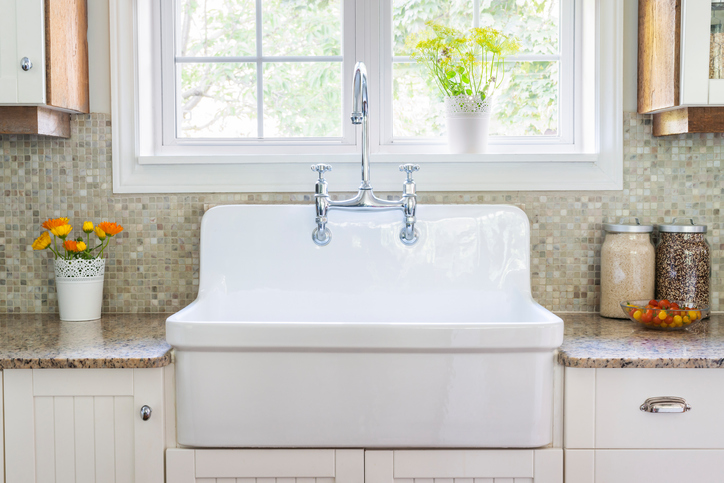
Popular kitchen sink accessories include:
- Drainboard. These sinks, popular in Europe, include a small drainboard that allows water from hand-washed dishes to run off into the sink. It is a great idea for small kitchens.
- Apron. A central feature of farmhouse-style sinks. The apron replaces the small portion of countertop in front of the sink and extends downward several inches to prevent water from splashing on the cabinetry. This style of sink allows easy access to the basin without reaching.
- Faucets and sprayers. A pull-out sprayer hidden within the faucet body simplifies cleaning, hand-washing and other tasks.
- Garbage disposal. This accessory is a workhorse in most kitchens. New disposals can be fancy or functional depending on your budget and usage requirements.
- Sink drain position. Drain position – centered or offset – dictates your storage space underneath the sink and overall dish-washing operations. Offset drains are usually best for smaller kitchens while centered drains are more common in larger sinks. Your existing plumbing setup also will dictate drain position.
Finding a Professional Kitchen Sink Installer
Finding a trusted, licensed kitchen sink installer can be difficult. An online search is likely to turn up several dozen plumbing and remodeling contractors. Modernize can help by pairing you with licensed contractors in your area so you can get quotes from three or four installation companies you like best.
A few things to keep top of mind when researching kitchen sink installers:
- Ask for references and photos of past installations.
- Request to see their license, and check your state contractors board to ensure the license is valid.
- Ask if the installer will remove your old sink, re-route any plumbing, if necessary, and dispose of any waste materials.
- Discuss payment options.
Good plumbing contractors and kitchen sink installers will be happy to provide homeowners with the information above. Let Modernize help you find reliable, pre-vetted contractors in your area that can kick off your kitchen remodel project and set you up with a new kitchen sink that meets your budget and design preferences.
